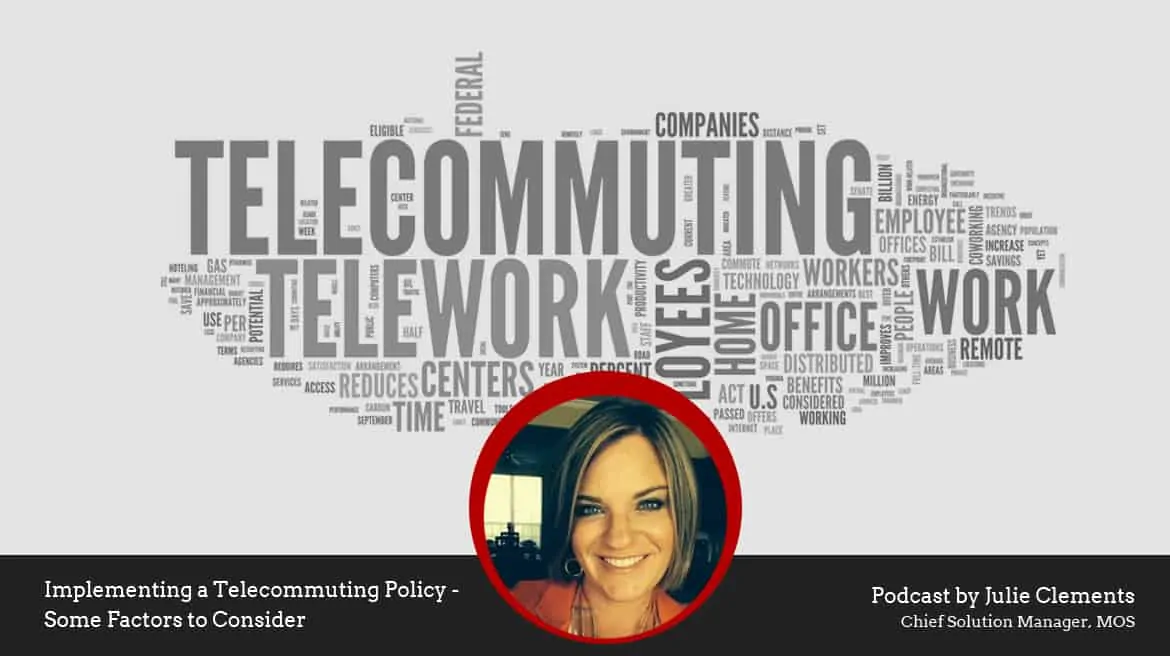Based in Tulsa, Oklahoma, MOS has been serving the legal, financial, insurance, and media industries for years. Backed by a dedicated team of professionals, our company is committed to providing focused, customized outsourcing solutions catering to each business niche.
In this podcast, Julie Clements, Chief Solutions Officer at Managed Outsource Solutions discusses the advantages of telecommuting and the factors businesses should consider before implementing this policy at their firm.
Read Transcript
The Internet, fax, phone, webcam, and instant messaging are some of the technological advances that make telecommuting possible. The top industries offering these opportunities include sales, customer service, marketing, medical and health, computer and information technology, education, government and finance. Nowadays, there’s a lot of data entry companies implementing this policy to help clients manage their data in a timely, efficient, and very secure manner.
Major companies, including Google and Intel have proved telecommuting can be successful. Well-designed, well-organized and well-managed telecommuting programs can offer a lot of different benefits to both employees and employers. These include increased productivity. As employees, you not have the distractions of the office space or the chit chat by the water cooler. It is better for the health and the environment of the employees and helps keep older generations in the workforce. It reduces your operating costs, also reduces your employee turnover and absenteeism. Teleworkers are more satisfied with their jobs and therefore are more likely to perform better, stay longer with the company.
Telecommuting is definitely, I believe, the future of work. Companies that allow their employees to telecommunicate are increasing year after year. FlexJobs and Global Workplace Analytics have released The 2017 State of Telecommuting in the U.S. Employee Workforce Report which shows that3.9 million U.S. employees or 2.9 percent of the total U.S. workforce work from home at least half of the time.
There has been a 115% percent increase in telecommuting between 2005 and2015 and about the same number of women and men telecommute, so it’s not one-sided in any way. Forty percent more U.S.employers offered flexible workspace options in 2017 than did in 2010.
A fewthings to consider before you do implement this program for your staff, before you let them work from home.
Technology – The success of telecommuting programs is based on the technical support provided to the employees. The organization should provide equipment to telecommuting employees to get work done effectively. The organization should decide who will be responsible for setting up and providing maintenance on the equipment, whether the employee needs to bring the equipment into the office for scheduled maintenance and upgrades, or whether that can be handled remotely. E-mail, web conferences, phone conferences and internal websites or networks that can be accessed from a remote location also contribute to the success of the telecommuting program. Employers should observe their organization’s IT infrastructure and determine whether their employees will be able to access the information and communicate with other employees, which is necessary to do their tasks.
The next factor to consider is whether the employee is eligible to work from home. You should determine whether the attitude and work ethics and personalities of the employee align with the company’s expectations of telecommuting. Not everyone can be productive when the boss is never around. So it is really essential to make sure that the employee will be successful at executing the arrangement. For that, the employer should consider the past performance of each employee, the nature of their position, how long they will be with the company, and so on, how frequently a staff member can telecommute such as full time, once a week, or once a month. In a major company like Xerox, an employee takes a self-assessment to determine if telework is a realistic option before considering this. Then the manager will take a similar assessment about the employee and both of them discuss their options together. There was another major company, I believe is Aetna, that evaluates telework options based on three things that include the individual (does the employee have the right capabilities and competencies), the job function (can the work be performed at home) and the home environment (must meet security standards). A lot of the work that we do we have to make sure that we meet HIPAA standards, so all our programs are secure. We need to make sure that they stay secure within the home.
Another thing is education and training. Another factor that the organization should also consider must be providing training to managers and how to effectively manage remote staff. It is essential to ensure that managers know how to communicate and collaborate with your virtual employees and vice versa. They should understand the soft skills as well how to use the right technologies to facilitate the desired interaction. It is also really important that virtual employees should receive their own type of training.
Another thing to consider is the cost. Telecommuting does involve cost. The organization should determine whether they will have to pay for an internet connection, a phone connection, or a cell phone contract. These costs must be considered before authorizing an employee to telecommute. If it’s not cost-effective for the company, then it would not be wise to implement this policy.
And also, I really think a big thing is that you need to set your standards and expectations for each employee, that is, given this opportunity, that you do believe that it’s an opportunity. Employees are required to sign a telecommuting agreement that would outline the various aspects of the telecommuting arrangement. Things that should be included in this agreement are, I would say: the agreed upon telecommuting schedule; what constitutes an approved remote workspace; expectations of availability during core business hours; maintaining proprietary and confidential information; liability waiver for the organization for loss or damage at an employee’s home; requirements for daycare or dependent care during the working hours; Workers’ compensation.
The employee’s approved work-space is considered an extension of the organization. It’s an extension of your office and during work hours, while the employee is performing his work functions, all company policies are still applied. So, expectations for conducting meetings with other employees and clients, employees and managers will regularly revisit the telecommuting arrangement and determine if it’s appropriate and effective for the telecommuting arrangement to continue.
It really is a privilege. I really feel like it’s important to explicitly state that remote work is a privilege that can be revoked if it is found that an employee is not meeting their expectations, while working outside the office. This will notify the employees that certain standards must be maintained in order to continue working offsite.
Considering these factors while developing a telecommuting program will allow your organization to determine if telecommuting is appropriate and help place the parameters around the program that suits the organization.
I love to telecommunicate. It has helped me in so many different ways my family and my husband, so when he can continue to further his career, I can continue with mine. So, I really think it’s a benefit, I wouldn’t change it for the world, but there are definitely matters you need to keep in place. If you want to learn a little more, please visit our website – www.managedoutsource.com.
Thank you very much! Bye Bye!




